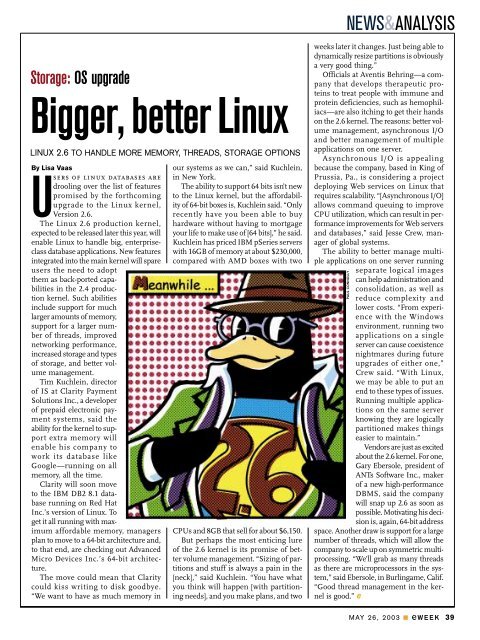Cisco - TABPI
Cisco - TABPI
Cisco - TABPI
You also want an ePaper? Increase the reach of your titles
YUMPU automatically turns print PDFs into web optimized ePapers that Google loves.
Storage: OS upgrade<br />
Bigger, better Linux<br />
LINUX 2.6 TO HANDLE MORE MEMORY, THREADS, STORAGE OPTIONS<br />
By Lisa Vaas<br />
Users of linux databases are<br />
drooling over the list of features<br />
promised by the forthcoming<br />
upgrade to the Linux kernel,<br />
Version 2.6.<br />
The Linux 2.6 production kernel,<br />
expected to be released later this year, will<br />
enable Linux to handle big, enterpriseclass<br />
database applications. New features<br />
integrated into the main kernel will spare<br />
users the need to adopt<br />
them as back-ported capabilities<br />
in the 2.4 production<br />
kernel. Such abilities<br />
include support for much<br />
larger amounts of memory,<br />
support for a larger number<br />
of threads, improved<br />
networking performance,<br />
increased storage and types<br />
of storage, and better volume<br />
management.<br />
Tim Kuchlein, director<br />
of IS at Clarity Payment<br />
Solutions Inc., a developer<br />
of prepaid electronic payment<br />
systems, said the<br />
ability for the kernel to support<br />
extra memory will<br />
enable his company to<br />
work its database like<br />
Google—running on all<br />
memory, all the time.<br />
Clarity will soon move<br />
to the IBM DB2 8.1 database<br />
running on Red Hat<br />
Inc.’s version of Linux. To<br />
get it all running with maximum<br />
affordable memory, managers<br />
plan to move to a 64-bit architecture and,<br />
to that end, are checking out Advanced<br />
Micro Devices Inc.’s 64-bit architecture.<br />
The move could mean that Clarity<br />
could kiss writing to disk goodbye.<br />
“We want to have as much memory in<br />
our systems as we can,” said Kuchlein,<br />
in New York.<br />
The ability to support 64 bits isn’t new<br />
to the Linux kernel, but the affordability<br />
of 64-bit boxes is, Kuchlein said. “Only<br />
recently have you been able to buy<br />
hardware without having to mortgage<br />
your life to make use of [64 bits],” he said.<br />
Kuchlein has priced IBM pSeries servers<br />
with 16GB of memory at about $230,000,<br />
compared with AMD boxes with two<br />
CPUs and 8GB that sell for about $6,150.<br />
But perhaps the most enticing lure<br />
of the 2.6 kernel is its promise of better<br />
volume management. “Sizing of partitions<br />
and stuff is always a pain in the<br />
[neck],” said Kuchlein. “You have what<br />
you think will happen [with partitioning<br />
needs], and you make plans, and two<br />
NEWS&ANALYSIS<br />
weeks later it changes. Just being able to<br />
dynamically resize partitions is obviously<br />
a very good thing.”<br />
Officials at Aventis Behring—a company<br />
that develops therapeutic proteins<br />
to treat people with immune and<br />
protein deficiencies, such as hemophiliacs—are<br />
also itching to get their hands<br />
on the 2.6 kernel. The reasons: better volume<br />
management, asynchronous I/O<br />
and better management of multiple<br />
applications on one server.<br />
Asynchronous I/O is appealing<br />
because the company, based in King of<br />
Prussia, Pa., is considering a project<br />
deploying Web services on Linux that<br />
requires scalability. “[Asynchronous I/O]<br />
allows command queuing to improve<br />
CPU utilization, which can result in performance<br />
improvements for Web servers<br />
and databases,” said Jesse Crew, manager<br />
of global systems.<br />
The ability to better manage multiple<br />
applications on one server running<br />
separate logical images<br />
can help administration and<br />
consolidation, as well as<br />
reduce complexity and<br />
lower costs. “From experience<br />
with the Windows<br />
environment, running two<br />
applications on a single<br />
server can cause coexistence<br />
nightmares during future<br />
upgrades of either one,”<br />
Crew said. “With Linux,<br />
we may be able to put an<br />
end to these types of issues.<br />
Running multiple applications<br />
on the same server<br />
knowing they are logically<br />
partitioned makes things<br />
easier to maintain.”<br />
Vendors are just as excited<br />
about the 2.6 kernel. For one,<br />
Gary Ebersole, president of<br />
ANTs Software Inc., maker<br />
of a new high-performance<br />
DBMS, said the company<br />
will snap up 2.6 as soon as<br />
possible. Motivating his decision<br />
is, again, 64-bit address<br />
space. Another draw is support for a large<br />
number of threads, which will allow the<br />
company to scale up on symmetric multiprocessing.<br />
“We’ll grab as many threads<br />
as there are microprocessors in the system,”<br />
said Ebersole, in Burlingame, Calif.<br />
“Good thread management in the kernel<br />
is good.” ´<br />
PAUL CONNOLLY<br />
MAY 26, 2003 n eWEEK 39













